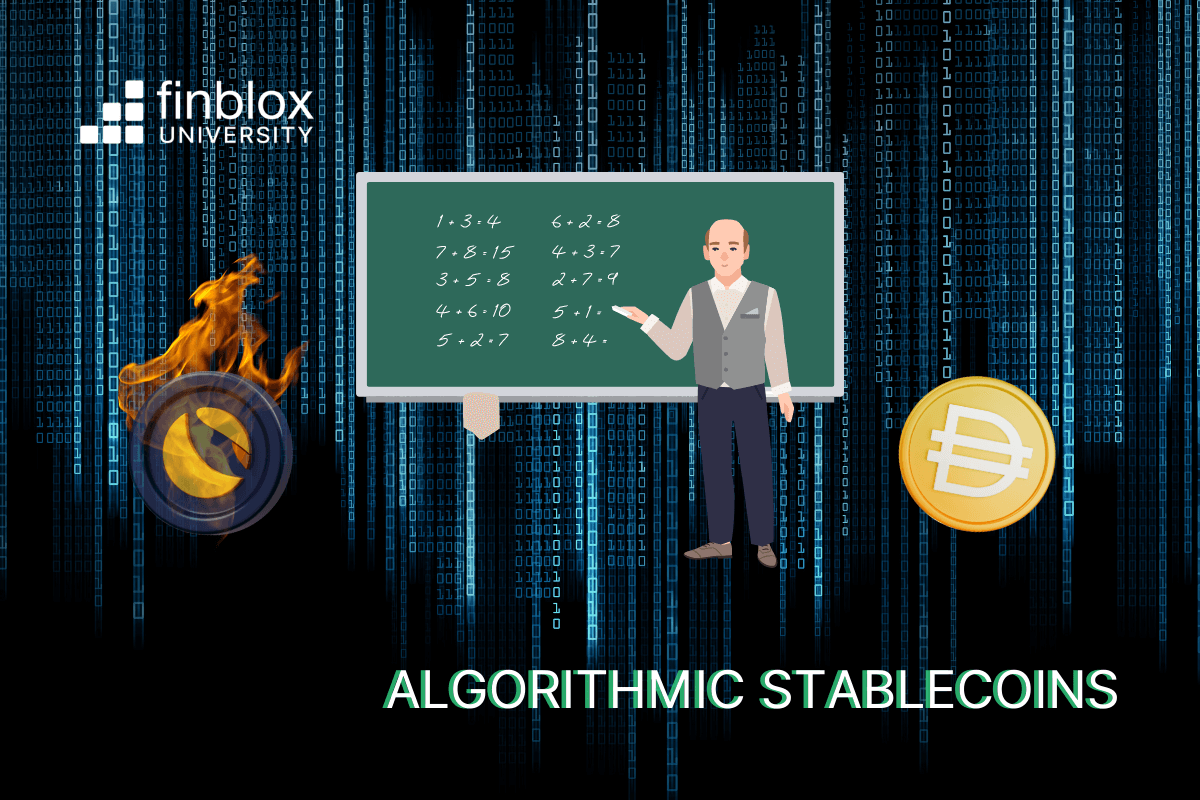Learn all about algorithmic stablecoins - including their collateralization, various pegging mechanisms, and most notable projects!
An algorithmic stablecoin is a stablecoin that is designed to maintain its fiat peg despite being completely uncollateralized - through a combination of smart contracts built into the code, supply/demand control mechanisms, and incentives that attract and reward market participants.
If you recall from our previous article about crypto savings platforms, an unsecured loan has no backing instrument of value to seize in the event that a borrower defaults. In the same sense, an uncollateralized asset has nothing of value to claim if it loses its peg and crashes to zero.
Traditional stablecoins maintain their fiat peg through a fiat reserve or backing crypto asset that acts as collateral. However, the goal of a pure algorithmic stablecoin is to be completely decentralized and not tied directly to a real-world asset in any way.
How do algorithmic stablecoins actually work?
The majority of algorithmic stablecoins maintain their peg through one of three mechanisms. Rebase, as the name implies - is a smart contract mechanism that continually adjusts the base supply of the asset to ensure that its value stays within a minimum acceptable standard deviation from the fiat currency that it is pegged to. You may find our article on tokenomics very helpful in understanding the supply-demand dynamics that are at work here.
Essentially, the contract will either "mint" or "burn" a token in response to buyers and sellers that drive the price up or down. Greater supply reduces the value, while scarcity increases the value of the stablecoin. If the value of the stablecoin starts to rise too high above $1, tokens will be minted to push the value back down. The opposite is true if the price falls too far below $1.
Seigniorage mechanisms can be thought of as a "scale" that uses one or more assets to balance the value of the primary stablecoin. The relationship between LUNA/UST is an unfortunate example of this. The protocol set trading rules that 1 UST = $1 in LUNA, and that the two could be freely exchanged at this rate no matter what the actual value of either asset was at the time.
Furthermore, purchasing UST required that some LUNA be burned - making the value of the remaining LUNA go up a bit. Purchasing LUNA would also require burning some UST, making the value of UST go up a bit. This created opportunities for arbitrage - which is just a fancy word for people who make profit from minor differences in the price between two assets.
When UST was trading lower than $1, traders would buy more UST at a discount because it could be traded for a higher value ($1) in LUNA, and vice-versa. This naturally-ingrained behavior and incentive provided to arbitrageurs was, theoretically - supposed to perpetually balance UST and LUNA. However, seigniorage ultimately failed when market conditions created massive selling pressure that was too great for the balancing act to keep up with.
Last but not least, fractional-algorithmic stablecoins are an emerging class of assets that maintain their peg through a combination of pure algorithmic mechanisms, and fiat-collateralized reserves. For example, 50% of the value of XYZ fractional token may be based on a US dollar reserve, while the remaining 50% is driven by a rebase smart contract.

What are some famous algorithmic stablecoins?
- TerraUSD (UST) was one of the most infamous seigniorage algorithmic stablecoins before its collapse. It was founded in 2018 by Do Kwon and Daniel Shin, and was built on the Cosmos protocol. Originally, it was designed to function as both a stablecoin and currency that could be used in other Cosmos-based applications such as Thorchain and Cronos. In September of 2021, the Columbus-5 upgrade enabled Terra to become interoperable with other blockchains. Terra 2.0 is in the works, but its future remains highly uncertain given the recent crisis and souring sentiment towards stablecoins.
- DAI is not a true algorithmic stablecoin, but one of the earliest pioneers in the space nonetheless. Created by MakerDAO on the Ethereum blockchain in 2017, DAI was designed to accept several cryptocurrencies as collateral in exchange for giving users the ability to take overcollateralized loans. These backing assets included Ethereum, USDC, wBTC, BAT, and more. In this sense, it was partially a seigniorage stablecoin - but also soft-pegged to the US dollar, making it much more stable. By manipulating loan interest rates, collateralization ratios, and accepted collateral types - DAI is able to maintain its peg.
- Frax Protocol (FRAX) was one of the first fractional-algorithmic stablecoins ever, founded by Sam Kazemian in 2019 alongside Jason Huan and Travis Moore. FRAX is partially collateralized by USDC, and also uses a seigniorage mechanism with Frax Shares (FXS) - which is periodically bought/sold to maintain FRAX's market capitalization. One unique feature of FRAX is the collateral ratio refresh function, which can be used once every hour to lower or raise the collateral ratio by a degree of 0.25% - allowing users greater control over their lending and borrowing. Over time, Sam hopes to see more users get comfortable with a greater portion of FRAX being collateralized by FXS, rather than USDC.
- Decentralized USD (USDD) is one of the newest algorithmic stablecoins, launched in 2022 by Justin Sun and Tron DAO. The mechanism behind USDD has an uncanny resemblance to LUNA/UST, as it continually creates and destroys units of USDD and Tron (TRX) to maintain its peg. However like DAI, it is collateralized by several assets including BTC, USDC, and USDT.
The Takeaway:
As an emerging asset class that has yet to pass the test of time, algorithmic stablecoins can be an incredibly risky investment despite the pure intentions that drive their decentralization and development. The recent fall of LUNA/UST only serves to highlight their weaknesses, especially given the height of their former glory when market sentiment was overwhelmingly favorable.
Finblox currently allows you to purchase and earn passive rewards on DAI, as it is partially-backed by more stable assets such as USDC and Ethereum that have proven to be good stores of value.
Thanks for reading! Please subscribe if you haven't already - and stay tuned for our next article, which will explore the relatively new concept of wrapped tokens.
This content is provided for informational purposes only, and should not be relied upon as legal, business, investment, or tax advice. You should consult your own advisers as to those matters. Charts, graphs and references to any digital assets are for informational and illustrative purposes only.


